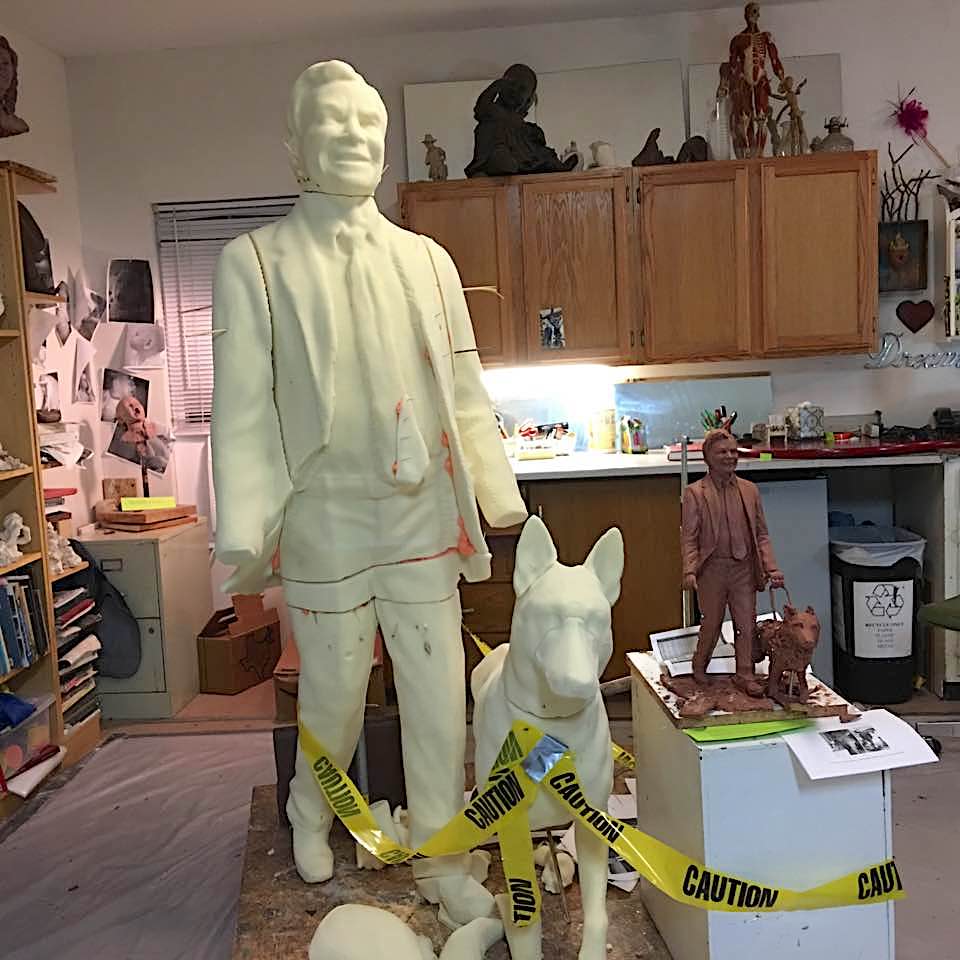Preparing to sculpt, Creating a Small Figurine, and using 3D Technology to make it big
Many are unfamiliar with the process of creating a sculpture or casting bronze. Bridgette’s website and blogs are full of information. Let us break it down for you here.
For more details be sure to check the blog post Categories. You can follow along on the creation of The Newsboy sculpture, Eve, Alice in Wonderland, The Prairie View Panther and the Grambling Tiger. You can even find posts for this sculpture of John Turner. Bridgette is a perpetual documenter and has documented the inspiration of many of her works of art.
If you are interested in Bridgette's combination of 3D Technology and fine art, she documents her progress and the progress of others in her book 3D Technology in Fine Art and Craft: Exploring 3D Printing, Scanning, Sculpting and Milling.

Deciding on a Pose | Measurements, Photographs & Reference
the Bridgette meets with the collector and presents suggestions for the final sculpture. The first step is coming up with a pose. Sometimes a photo sessions with the subject or a stand-in may be necessary. With some commissions, if the subject is not available, the sculptor will pose a model. She uses clothes from the subject and gathers as many reference photographs as possible.
Another important thing to review is the space where the client intends to install the sculpture. The artist visits the area to see the best placement. Visiting the intended location helps her to know many details.
Besides having the photographic reference, Bridgette also looks for inspiration elsewhere. Who knows the subject best? In the case of John Turner, Bridgette spent time getting to know more about John’s life as a blind man. She also researched legacy of seeing eye dogs. John had a variety of seeing eye dogs in his life. Bridgette needs to get the right look for this dog. It is also essential to know exactly how the dog would stand compared to her main subject. Accuracy is important.

Initial Approval | Small Maquette
Sometimes the artist will create a small sculpture for approval. This is sometimes referred to as a maquette. If the client wants to have this maquette cast into a small bronze as a keepsake, this is a possibility. Be sure to ask for a cost for this addition. The artist may also crate the maquette as a 3D digital image, If the clay maquette processes is not required or sufficient for the project. Or the artist may create a digital model for approval.



3D Scanning the Maquette & Creating a Foam Armature.
An armature gives the sculptured clay support. The artist created an armature for John Turner’s sculpture digitally. First, the statue is 3D scanned. Scanning collects all the details of the small figure. Once the artist gets a digital file, she sends the data to a vendor who carves it from urethane foam using a CNC milling machine. (CNC stands for Computer Numerically Controlled Milling.) The armature is the underlying support system of the entire sculpture. A well planned and built armature is essential to a successful sculpture.
Creating the Life Size Sculpture.


First, Bridgette carves in the foam, adding more depth and detail. Then she adds a thin layer of clay with more detail. The sculpting process is very time consuming and labor intensive. It is usually the longest part of creating a bronze. Patience and a good eye for detail are necessary in creating a good likeness and a natural sculpture.
The Finished Clay Sculpture and Final Approval
Once the artist finishes the clay sculpture, her clients must approve it. The client can approve in person in Bridgette’s studio or through video and photographs. Bridgette looks forward to any suggestions that clients may have for tweaking the sculpture. Suggestions often help bring out subtle nuances that make the final sculpture more personal. When coming to the approval, John's wife said she felt like her husband was actually standing there.
On to mold making.



Check Out the Next Steps in the Process...








